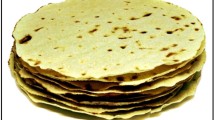Abstract
Storage studies of artificially sweetened lassi samples revealed that the binary sweetener aspartame × acesulfame-k blend (0.05% equivalence, 50:50, 0.05%*) was the best blend as it resembled control in all the sensory attributes up to 5 days of storage. Increase in acidity and viscosity and decrease in pH of artificially sweetened lassi samples was similar to control lassi during storage and was not influenced by the addition of sweetener/sweetener blends. The decrease in lactic and increase in yeast and mold counts obtained during storage of lassi were highly influenced by sucrose. Analysis of aspartame, acesulfame-k, saccharin, and sucralose added, either singly or in blends in lassi, showed their stability throughout the storage period as analyzed over high performance liquid chromatography/high pressure thin layer chromatography plates.

Similar content being viewed by others
References
Arora, S., Narendra, K., Gawande, H., Singh, V. P., Yarrakula, S., Sharma, V., et al. (2008a). Stability of artificial sweeteners saccharin, acesulfame-k and aspartame in flavoured milk. Indian Journal of Dairy science, 61, 335–341.
Arora, S., Yarrakula, S., Narendra, K., Sharma, V., Wadhwa, B. K., Singh, A. K., et al. (2008b). Analysis of saccharin and acesulfame-k and their storage stability in kalakand. Indian Journal of Dairy Science, 61, 170–177.
Arora, S., Singh, V. P., Sharma, V., Wadhwa, B. K., George, V., Singh, A. K., et al. (2009). Analysis of sucralose and its storage stability in burfi. Journal of Food Science & Technology, 46, 114–117.
Arpe, H.J. (1978). Acesulfame-K, a new noncaloric sweetener. In: B Guggenheim. Ed. Health and Sugar Substitutes. Proceeding of the ERGOB Conference, Geneva 1978. (pp 178–179). Basel: Karger.
Barndt, R. L., & Jackson, G. (1990). Stability of sucralose in baked goods. Food Technology, 44, 62–66.
Bell, L. N., & Labuza, T. P. (1991). Aspartame degradation kinetics as affected by pH in intermediate and low moisture food systems. Journal of Food Science, 56, 17–19.
George, Vishwas (2007). Analysis of multiple sweeteners and their stability in lassi. PhD Thesis. Division of Dairy Chemistry, National Dairy Research Institute, Karnal, Haryana, India. P-917
George, V., Arora, S., Sharma, V., Wadhwa, B. K., Sharma, G. S., & Singh, A. K. (2006). Sweetener blends and their applications—A review. Indian Journal of Dairy Science, 59, 131–138.
Ghodekar, D. R., Ranganathan, B., & Dudani, A. T. (1980). Yeast and mold in indigenous milk products. Indian Journal of Dairy Science, 33, 255–259.
IS: SP-18 Part I (1980). ISI Handbook for food analysis. Bureau of Indian Standards, Manak Bhavan: New Delhi
IS: SP-18 Part XI (1981). ISI Handbook for food analysis-Dairy Products. Bureau of Indian Standards, Manak Bhavan: New Delhi
Lipinski, G. W. (1988). Einsatz von Sunett in Joghurt und anderen Milcherzeugnissen. Swiss Food, 10, 25–29.
Lipinski, G. W., & Hanger, H. C. (2004). In L. O’Brien Nabors (Ed.), Acesulfame-K. Alternative Sweeteners (3rd ed., pp. 20–26). New York: Marcel Dekker, Inc.
Mital, B. K., & Steinkraus, K. H. (1975). Utilization of oligosaccharides by lactic acid bacteria during fermentation of soy milk. Journal of Food Science, 40, 114–118.
National Industrial Chemicals Notification and Assessment Scheme (2001). Full Public Report, 1, 6-dichloro-1, 6-dideoxy-β-D fructofuranosyl-4-chloro-4-deoxy-α-D-galactose; File No: NA/944, November.
PFA (2004). Notification amending PFA rule 1955, Issued by Ministry of Health and Family Welfare, Published in the Gazette of India (Extraordinary) No. 273, Part–II, Section 3, Subsection (i) dated 25.06.04.
PMC Specialties Group. (2004). Food and feed - The sweet facts. www.pmcsg.com/markets/fdf/sweetchew.asp, Accessed on 2/03/2006.
Raju, P. N., & Pal, D. (2009). The physico-chemical, sensory, and textural properties of misti dahi prepared from reduced fat buffalo milk. Food and Bioprocess Technology, 2, 101–108.
Snedecor, G. W., & Cochran, W. G. (1989). Statistical methods (8th ed.). USA: Affiliated East-West Press, Iowa State Univ Press.
www.food.gov.UK. (2001). Sucralose—Technological Justification. 24 January. Accessed on 26/01/2006.
www.splendaingredient.co.uk. (2006). Splenda. Accessed on 18/02/2006.
Acknowledgments
The authors express their appreciation to PMC Specialities Group Inc., NutraSweet Company, Nutrinova Specialities & Food Ingredients, and Tate & Lyle Sucralose Inc., for supplying ingredients for this study.
Author information
Authors and Affiliations
Corresponding author
Additional information
Single asterisk denotes the levels of sweeteners added in lassi.
Rights and permissions
About this article
Cite this article
George, V., Arora, S., Sharma, V. et al. Stability, Physico-Chemical, Microbial and Sensory Properties of Sweetener/Sweetener Blends in Lassi During Storage. Food Bioprocess Technol 5, 323–330 (2012). https://doi.org/10.1007/s11947-009-0315-7
Received:
Accepted:
Published:
Issue Date:
DOI: https://doi.org/10.1007/s11947-009-0315-7




